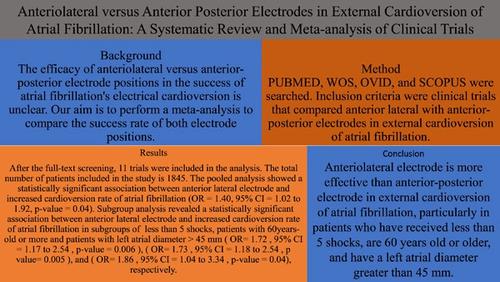当前位置:
X-MOL 学术
›
Clin. Cardiol.
›
论文详情
Our official English website, www.x-mol.net, welcomes your
feedback! (Note: you will need to create a separate account there.)
Anteriolateral versus anterior–posterior electrodes in external cardioversion of atrial fibrillation: A systematic review and meta-analysis of clinical trials
Clinical Cardiology ( IF 2.4 ) Pub Date : 2023-02-09 , DOI: 10.1002/clc.23987
Karam R Motawea 1 , Mostafa R Mostafa 2 , Merna Aboelenein 1 , Mohamed Magdi 2 , Hager Fathy 3 , Sarya Swed 4 , Mohamed M Belal 1 , Dina M Awad 1 , Rowan H Elhalag 1 , Nesreen E Talat 1 , Samah S Rozan 1 , Abdulqadir J Nashwan 5 , Naim Battikh 6 , Bisher Sawaf 7 , Mhd K Albuni 7 , Elias Battikh 7 , Gihan M Mohamed 7 , Amr Farwati 7 , Hani Aiash 8
Clinical Cardiology ( IF 2.4 ) Pub Date : 2023-02-09 , DOI: 10.1002/clc.23987
Karam R Motawea 1 , Mostafa R Mostafa 2 , Merna Aboelenein 1 , Mohamed Magdi 2 , Hager Fathy 3 , Sarya Swed 4 , Mohamed M Belal 1 , Dina M Awad 1 , Rowan H Elhalag 1 , Nesreen E Talat 1 , Samah S Rozan 1 , Abdulqadir J Nashwan 5 , Naim Battikh 6 , Bisher Sawaf 7 , Mhd K Albuni 7 , Elias Battikh 7 , Gihan M Mohamed 7 , Amr Farwati 7 , Hani Aiash 8
Affiliation

|
The efficacy of anteriolateral versus anterior–posterior electrode positions in the success of atrial fibrillation's (AF) electrical cardioversion is unclear. Our aim is to perform a meta-analysis to compare the success rate of both electrode positions. PUBMED, WOS, OVID, and SCOPUS were searched. Inclusion criteria were clinical trials that compared anterior–lateral with anterior–posterior electrodes in external cardioversion of AF. After the full-text screening, 11 trials were included in the analysis. The total number of patients included in the study is 1845. The pooled analysis showed a statistically significant association between anterior–lateral electrode and increased cardioversion rate of AF (odds ratio [OR] = 1.40, 95% confidence interval [CI] = 1.02–1.92, p = .04). Subgroup analysis revealed a statistically significant association between the anterior–lateral electrode and increased cardioversion rate of AF in subgroups of less than five shocks, patients with 60 years old or more and patients with left atrial (LA) diameter >45 mm (OR = 1.72, 95% CI = 1.17–2.54, p = .006), (OR = 1.73, 95% CI = 1.18–2.54, p = .005), and (OR = 1.86, 95% CI = 1.04–3.34, p = .04), respectively. Anteriolateral electrode is more effective than anterior–posterior electrode in external cardioversion of AF, particularly in patients who have received less than 5 shocks, are 60 years old or older and have a LA diameter greater than 45 mm.
中文翻译:

心房颤动体外心脏复律的前外侧电极与前后电极:临床试验的系统评价和荟萃分析
前外侧电极位置与前后电极位置对心房颤动 (AF) 心脏电复律成功的疗效尚不清楚。我们的目标是进行荟萃分析以比较两个电极位置的成功率。检索了 PUBMED 、 WOS 、 OVID 和 SCOPUS。纳入标准是比较 AF 体外心脏复律中前外侧电极和前后电极的临床试验。全文筛选后,纳入 11 项试验纳入分析。研究纳入的患者总数为 1845 人。汇总分析显示前外侧电极与 AF 心脏复律率增加之间存在统计学意义关联 (比值比 [OR] = 1.40,95% 置信区间 [CI] = 1.02-1.92,p = .04)。亚组分析显示,在电击少于 5 次的亚组中,60 岁或以上的患者和左心房 (LA) 直径 >45 mm 的患者 (OR = 1.72,95% CI = 1.17–2.54,p = .006),(OR = 1.73,95% CI = 1.18–2.54,p = .005),(OR = 1.73,95% CI = 1.18–2.54,p = .005), 和 (OR = 1.86,95% CI = 1.04–3.34,p = .04)。在 AF 的体外心脏复律中,前外侧电极比前后电极更有效,特别是对于电击次数少于 5 次、年龄在 60 岁或以上且 LA 直径大于 45 mm 的患者。
更新日期:2023-02-09
中文翻译:

心房颤动体外心脏复律的前外侧电极与前后电极:临床试验的系统评价和荟萃分析
前外侧电极位置与前后电极位置对心房颤动 (AF) 心脏电复律成功的疗效尚不清楚。我们的目标是进行荟萃分析以比较两个电极位置的成功率。检索了 PUBMED 、 WOS 、 OVID 和 SCOPUS。纳入标准是比较 AF 体外心脏复律中前外侧电极和前后电极的临床试验。全文筛选后,纳入 11 项试验纳入分析。研究纳入的患者总数为 1845 人。汇总分析显示前外侧电极与 AF 心脏复律率增加之间存在统计学意义关联 (比值比 [OR] = 1.40,95% 置信区间 [CI] = 1.02-1.92,p = .04)。亚组分析显示,在电击少于 5 次的亚组中,60 岁或以上的患者和左心房 (LA) 直径 >45 mm 的患者 (OR = 1.72,95% CI = 1.17–2.54,p = .006),(OR = 1.73,95% CI = 1.18–2.54,p = .005),(OR = 1.73,95% CI = 1.18–2.54,p = .005), 和 (OR = 1.86,95% CI = 1.04–3.34,p = .04)。在 AF 的体外心脏复律中,前外侧电极比前后电极更有效,特别是对于电击次数少于 5 次、年龄在 60 岁或以上且 LA 直径大于 45 mm 的患者。







































 京公网安备 11010802027423号
京公网安备 11010802027423号